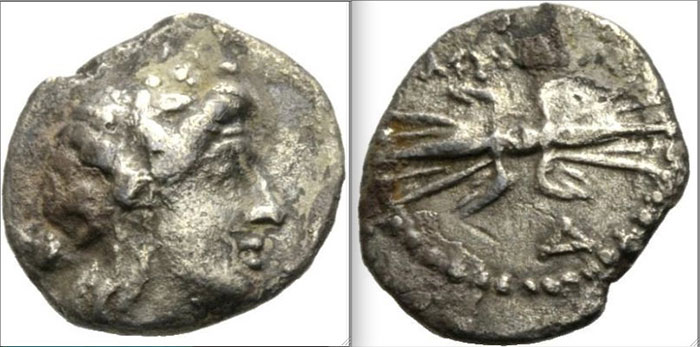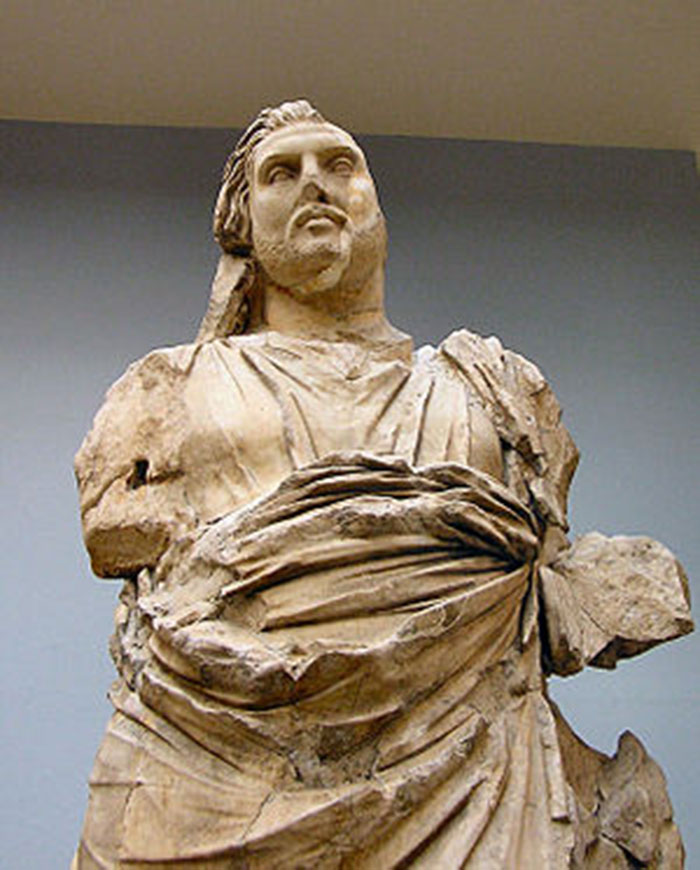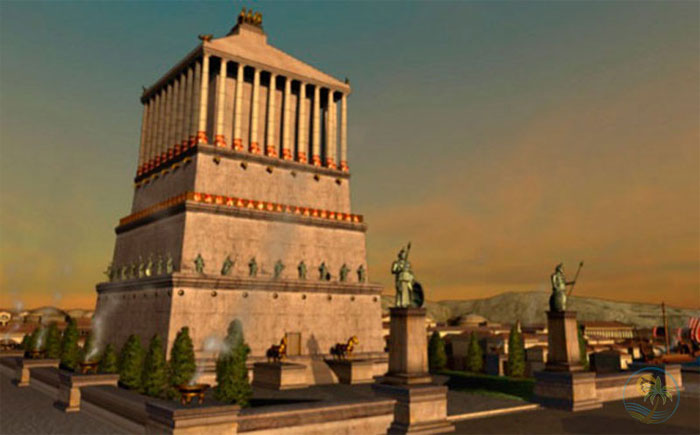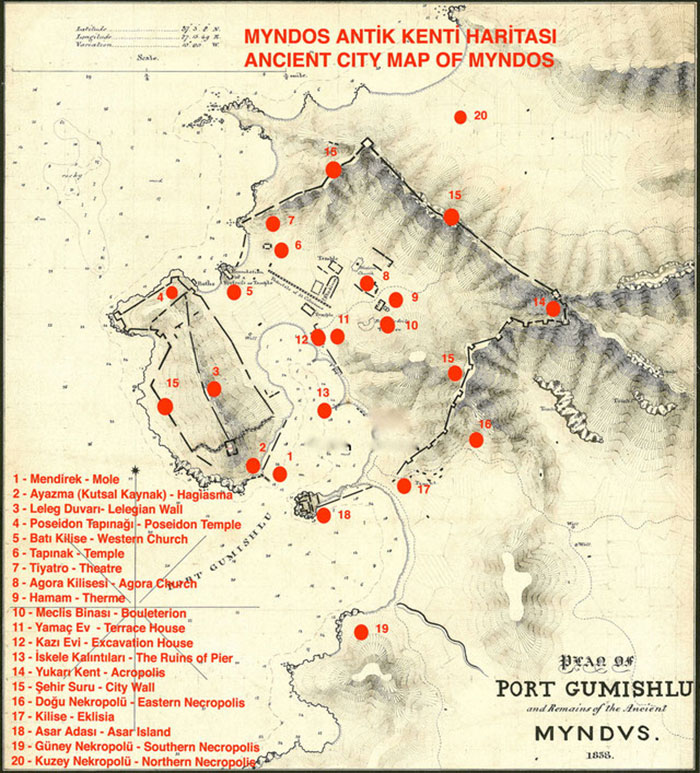Antik kent Gümüşlük ya da Myndos
Myndos tarihçe
Myndos antik kenti bugünkü Gümüşlük beldesinin yanındaki Bozdağı üzerine kurulmuş.
Tarih öncesi çağlara dayanan ilk kültürünü Lelegler oluşturur. Deniz ticaretini ellerinde tutan bu savaşçı ulus Myndos´a yerleşmiştir. Yani, Myndos antik kentinin ilk sakinleri Leleglerdir. Bozdag üzerine bu şehri kurmuslar. Antik yazar Apollodorus`a göre Kral "Lelex" in ismi sebebiyle bölgeye de Leleg ismi konulmuştur.

Kaynak: İnternet - Myndos. 2nd-1st centuries BC. AR Hemidrachm. Head of Dionysos right, wearing ivy-wreath; thyrsos over shoulder / MUNDAIWN , Winged thunderbolt
Lelegler yunanca konusmuyorlardı ve Avrupa kavimleriyle ilgileri yoktu. Homer Ilias`da Lelegleri Truvalilarin yoldasi olarak betimlemis. Roma Imparatorlugu döneminde tekrar önem kazanan Myndos, Milattan sonra 44 senesinde Sezar`in katilleri Brutus ve Cassius tarafindan karargah olarak kullanılmış.
Gümüslük'den (Myndos) çok önemli filozoflar çıkmıştır. Myndoslu Eusebios eğitimini, milattan sonra 351 yilinda Roma imparatoru Julian`a da filozofi dersleri veren meşhur Filozof Aidesios`dan aldı. Yaşlanan Aidesios`dan görevi devralan Eusebios Roma imparatoru Julian`i olağanüstü ögretme yetenegiyle kendisine hayran birakmıştır.
LELEGLERDEN SONRA PERSLER
Myndos, Leleglerden sonra Dorlar, daha sonra Persler, M.Ö. 3. y.y.da da Karyalıların egemenliğine girmiştir. O dönem Pers Krallığı'na bağlı bir satraplık olan Karia satraplığı sınırları içindedir. Satraplık bugünkü anlamıyla valiliktir.
Mausolos (Maussollos) (M.Ö. 352-353) (Yunanca: Μαύσωλος veya Μαύσσωλλος), Güneybatı Anadolu'daki Karya bölgesinin Pers satrapıdır. Yani Pers Krallığı'nın bölgedeki valisidir. Pers hükümdarına bağlı olmakla birlikte daha çok bağımsız bir kral gibi hareket etmiştir.

Kaynak: İnternet - Mausolos
Pers satraplarının tümü Büyük Kral tarafından anayurttan gönderilen Persli yüksek memurlardır. Bu kurala uymayan tek satraplık Karia satraplığıdır. Karia satrapları öz be öz Karialı bir sülaledir. Bu hanedan ailesi Hekatomnos oğulları ya da Hekatomnid sülalesi olarak adlandırılır. Bu sülalenin en önemli ismi kuşkusuz Mausolos (Maussollos)`dur.
Kyndia`lı Hyssaldomos M.Ö.392`de ölünce yerine geçen oğlu Hekatomnos hanedanlığını bir şekilde güçlendirerek Lydia satraplığından kopartıp Karia satraplığını ele geçirmiştir. Bu dönemde Hekatomnos`un tam 100 parçalık dönemine göre oldukça büyük bir donanması bulunmaktaydı.
Ancak Karia tarihindeki en önemli isim kuşkusuz Hekatomnos`un en büyük oğlu olan Maussollos`dur. Satrap Maussollos agresif ve yayılmacı bir politika güderek satraplık sınırlarına Lykia bölgesini de katmıştır.
Maussollos büyük bir inşa programını başlatarak Karia`da yeni kentler kurmuş, anıtlar inşa etmiş ve bölgeyi tarihi boyunca ulaştığı en yüksek kültürel, maddi ve politik güce kavuşturmuştur.
Maussollos Büyük Kral ile arasını her zaman iyi tutmuş ve ona sadık gözükerek başına buyruk bir kral gibi ülkesini yönetmiştir. Buna karşın asla bir kral olamamıştır.
Mausulos günümüzde daha çok eşi tarafından kendisi için yaptırılan ve Dünyanın Yedi Harikası'ndan biri olan Halikarnas Mozolesi ile anılır.
Müttefikler Savaşı sırasında Rodos ve Byzantion’un yanında yer alarak Atina’ ya karşı tavır alır. Bu savaş sonunda topraklarını daha da genişletir. Egemenlik alanı büyüyünce başkentini Mylasa’dan (bugün Milas) Halikarnasos’a (bugün Bodrum) taşır.
Halikarnassos onun döneminde eski Yunan kentlerinin en görkemlisidir. II. Artemisia ile evlenerek kraliçe olmasını sağlar. Ölümünden sonra yerine geçen II. Artemisia, Dünya’nın Yedi Harikası’ndan biri olan Halikarnossos’taki Mausoleium’u (anıt mezar) yaptırmaya başlar. Ancak iki yıl sonra o da ölünce, bu anıtsal mezarı yapan sanatçılar tamamlar.

Kaynak: İnternet - Mausolos adına yaptırılan Halikarnas Mozolesi
Mezar Muğla, Bodrum‘un Halikarnassos Antik Kentinde (Halikarnas) bulunmaktaydı. Mezarın toplam uzunluğu 45 metre idi. Mezari piramidi andıran katlı merdivenler şeklindeydi ve dört bir tarafında da farklı heykeltıraşlar tarafından yapılmış insan ve hayvan heykellerine sahipti.
O döneme kadar sadece Tanrıların heykelleri yapılmıştı. Bu yapı, ilk kez diğer canlıların heykellerinin yapılması bakımından ayrı bir önem taşımaktadır.
1402'de Saint Jean şövalyeleri Bodrum’a gelip anıtı ilk başta taş ocağı olarak kullanmış daha sonra anıtı sökerek Bodrum Kalesi'ni yapmışlardır.

Kaynak: İnternet - Myndvs - Myndos antik kenti haritası
Arkeolojik sit alanı olması nedeni ile korunan çevre, doğallığını büyük ölçüde muhafaza etmektedir. Halikarnas Kralı Mausolos'un kurmuş olduğu Myndos Kentinin kalıntıları geçen yüzyıllardaki büyük depremlerin sonucunda kısmen su altında kısmen de toprak altında kalmıştır. Bu nedenle antik Myndos Kenti ''Batık Şehir'' olarak da anılır.
Koyun girişindeki Tavşan Adası'na (Asar Adası) Batık Şehrin taşları üzerinden yürüyerek geçilebilir.
HARİTA
Haritaya tıklayarak büyütebilirsiniz.
History of Gumusluk
Myndos history
The ancient city of Myndos was founded on Bozdagi, next to the present-day Gumusluk town.
Lelegs form the first culture dating back to prehistoric times. This warrior nation, which controlled the maritime trade, settled in Myndos. In other words, the first inhabitants of the ancient city of Myndos were Leleges. They established this city on Bozdag. According to the ancient writer Apollodorus, the region was named Leleg because of the name of King "Lelex".
The Leleges did not speak Greek and had nothing to do with European tribes. In Ilias, Homer described the Leleges as the companions of the Trojans. Myndos, which gained importance again during the Roman Empire, was used as a headquarters by Caesar's murderers Brutus and Cassius in 44 AD.
Very important philosophers came out of Gumusluk (Myndos). Eusebius of Myndos received his education from the famous philosopher Aidesios, who also gave philosophy lessons to the Roman emperor Julian in 351 BC. Eusebius, who took over from the aging Aidesios, impressed the Roman emperor Julian with his extraordinary teaching ability.
THE PERSIANS AFTER THE LELEGIES
Myndos, Lelegs, then Dorians, then Persians, BC. In the 3rd century, it was dominated by the Carians. It was within the borders of the Karia satrapy, which was a satrapy attached to the Persian Kingdom at that time. The satrapy, in its current sense, is the governorship.
Mausolos (Maussollos) (352-353 BC) (Greek: Μαύσωλος or Μαύσσωλλος) is the Persian satrap of the Caria region in Southwest Anatolia. In other words, he is the governor of the Persian Kingdom in the region. Although he was loyal to the Persian ruler, he acted more like an independent king.
The Persian satraps are all Persian high officials sent from the homeland by the Great King. The only satrapy that does not follow this rule is the Carian satrapy. The Carian satraps are a quintessentially Carian dynasty. This dynasty family is called the sons of Hekatomnos or the Hekatomnid dynasty. The most important name of this dynasty is undoubtedly Mausolos (Maussollos).
When Hyssaldomos of Kyndia died in 392 BC, his son Hekatomnos, who succeeded him, strengthened the dynasty somehow, breaking it off from the Lydian satrapy and seizing the Caria satrapy. In this period, Hekatomnos had a rather large navy compared to the 100-piece period.
However, the most important name in the history of Caria is undoubtedly Maussollos, the eldest son of Hekatomnos. Satrap Maussollos, following an aggressive and expansionist policy, added the Lycian region to the borders of the satrapy.
By starting a major construction program, Maussollos established new cities, built monuments in Caria, and gave the region the highest cultural, material and political power it has reached throughout its history.
Maussollos always kept good relations with the Great King and seemed loyal to him and ruled his country like a maverick king. However, he never became a king.
Today, Mausulos is mostly remembered for the Halicarnassus Mausoleum, one of the Seven Wonders of the World, built for him by his wife.
During the Allied War, he sided with Rhodes and Byzantion and took a stand against Athens. At the end of this war, he expands his territory even more. When his domain grew, he moved his capital from Mylasa (today Milas) to Halicarnassus (today Bodrum).
Halicarnassus was the most magnificent of the ancient Greek cities during his reign. II. He marries Artemisia and makes her queen. After his death, II. Artemisia begins to build the Mausoleum (mausoleum) in Halikarnossos, one of the Seven Wonders of the World. However, when he died two years later, the artists who built this monumental tomb completed it.
The tomb was located in the Ancient City of Halicarnassus (Halikarnas) in Muğla, Bodrum. The total length of the tomb was 45 meters. It was in the form of tiered staircases resembling a tomb pyramid and had human and animal sculptures made by different sculptors on all four sides.
Until that time, only statues of gods were made. This structure is of particular importance in terms of making sculptures of other living things for the first time.
In 1402, the Knights of Saint Jean came to Bodrum and used the monument as a quarry at first, then they dismantled the monument and built the Bodrum Castle.
The environment, which is protected due to being an archaeological site, preserves its naturalness to a large extent. The ruins of Myndos City, which was founded by King Mausolos of Halicarnassus, were partially underwater and partially underground as a result of the great earthquakes in the past centuries. For this reason, the ancient city of Myndos is also known as the "Sunken City".
The Rabbit Island (Asar Island) at the entrance of the bay can be reached by walking over the stones of the Sunken City.
VİDEO







